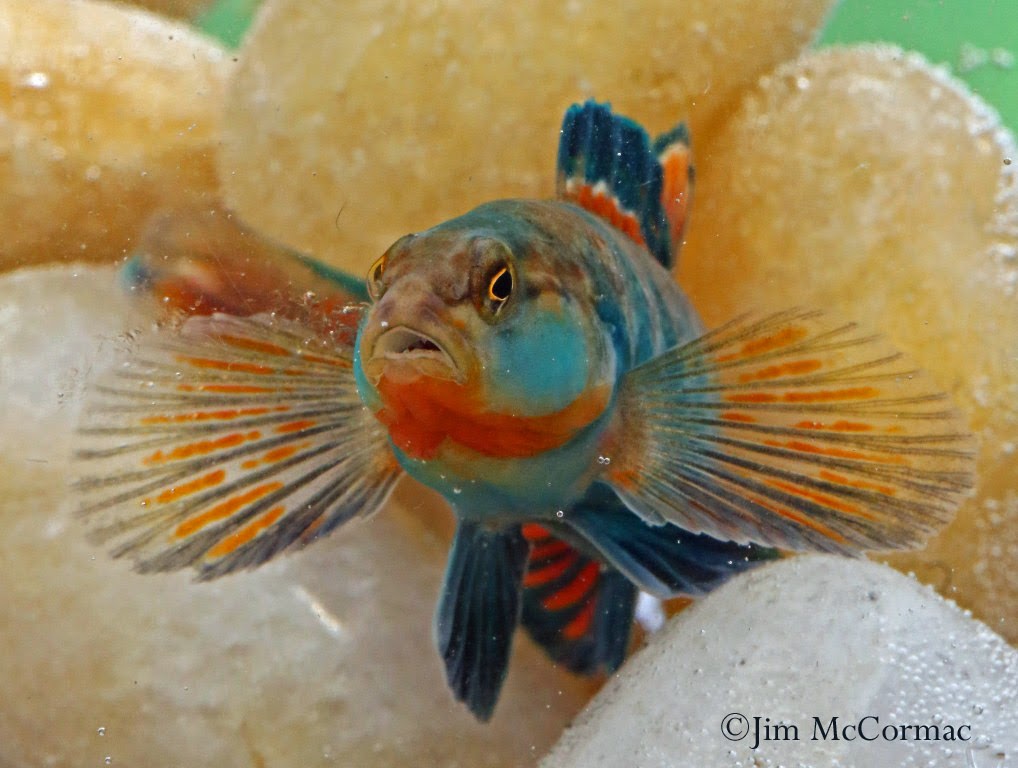This rainbow darter, Etheostoma caeruleum, is aptly named and would look right at home in a tropical fish tank.
Not long ago, I wrote an account of a recent excursion to Little Darby Creek, which can be seen HERE.I was indeed fortunate to accompany Mac Albin of Franklin County Metroparks, Anthony Sasson of the Ohio Chapter of The Nature Conservancy, and John Tetzloff of the Darby Creek Association. No one knows the fishes of Big and Little Darby creeks like these guys do.
We caught lots of fish, all of which were released back into the waters. We were "fish-watching"; temporarily detaining some of the stream's more colorful denizens so we could study them, and take photos. A pair of brilliant rainbow darters pose in the photo above.
Rainbow darters are common, and occur in streams nearly statewide. Nonetheless, few people have seen one and most might be surprised to know that such a riotously colored animal lurks on our stream bottoms. Although there are a number of rarer darter species in Ohio and in the Darby Creeks, the common rainbow darter is still my favorite. Although most of the other species are finned works of art, too, none of them can top the rainbow in the looks department.
At the very peak of breeding season, when the waters become just the right temperature, male darters shift their colors into overdrive. As many songbirds molt into bright alternate, or breeding, plumage, so do the darters in their own way. Seine up a rainbow darter in the heat of late summer, and it'll be a much muted version of the fish above. At the apex of the breeding season, some rainbow darters become heavily infused with blue, as is the animal in this photo.
It's not only darters that enter a "breeding plumage". A great many other stream fish do the same. This is our largest minnow species, the stoneroller, Campostoma anomalum. It is a very common stream fish throughout the state, and is rather tolerant of pollution and other forms of stream degradation.The curious name stems from their habit of grazing algae from rock cobble in the riffles in which they occur.
This male stoneroller is entering breeding condition, as evidenced by the appearance of warty tubercles on the dorsal surface of its head and back. Before long, it will also develop spectacular black and orange pigments in its dorsal and caudal fins, and the black etchings on its body will become richer and more pronounced. Many plain jane minnows briefly become quite festive in their coloration during breeding season.
Like many stream fish, stonerollers make a nest. The male hollows out a spawning pit near a riffle, and vigorously defends it from other males. An interested female will slink in and deposit her eggs within the spawning pit. In the case of the stoneroller, the male will abandon the nest prior to the eggs hatching, but some species of fish guard their nests right up to the point that the fry emerge.
A healthy stream bottom is its own little world, but one that is out of sight and largely out of mind.
While photographing and closely observing this stoneroller in the holding tank, I noticed something that was news to me. Scroll to the preceding photo, then back to the above image. Note how the fish can roll its eye in its socket. I always assumed fish, or most fish anyway, had their eyes fixed in the sockets. Maybe it was ignorant of me to think that, but then again, how often does one get to closely observe fish?
In the case of the stoneroller, it would make sense that it would evolve an ability to shift its eyes downward, the better to see potential foodstuff on the rocks below.
This is one of my all-time favorite fish, the mottled sculpin, Cottus bairdii. It is a bit more habitat-specific than the preceding two species, preferring smaller streams with cooler water temperatures than are found in larger rivers.
Sculpins lurk in the rocky cobble of riffles, and elsewhere on the stream bottom. They blend with their surroundings quite well, specially when among stones.
If you were a darter, or any other smaller animal, you would not want to glance up and find this face staring at you. Sculpins are predators, and snap up small fish and a variety of other stream animal life. The victims probably have little warning, as the cryptic sculpin would be hard to detect. For the prey, it is probably as if one of the riffle's rocks suddenly exploded to life, and sucked you in with a giant swallow of that proportionately enormous mouth.
Thanks again to Mac, Anthony, and John for an excellent field trip. I hope to do more of these aquatic forays in the future. Kudos too to their respective organizations for all of the work that they do to protect Big and Little Darby Creek. These streams are among the highest quality waterways in the Midwest, and it is imperative that they remain so. Most Ohio streams have not fared nearly as well, and as a result, even common fishes such as those that I've shared in these posts are not nearly as common as they once were.










2 comments:
This was interesting--I never knew this, though I guess it would make sense that fish might have mating "plumage" much like the birds.
Incredible photos, Jim! Thank you for taking the time to render such
high quality portraits for this "fishy" story.
Cheryl
Post a Comment